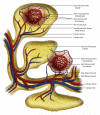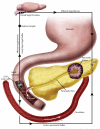Overview of exocrine pancreatic pathobiology
- PMID: 24190915
- PMCID: PMC4360889
- DOI: 10.1177/0192623313509907
Overview of exocrine pancreatic pathobiology
Abstract
Exocrine pancreas is a source of several enzymes that are essential for the digestive process. The exocrine pancreatic secretion is tightly regulated by the neuroendocrine system. The endocrine pancreas is tightly integrated anatomically and physiologically with the exocrine pancreas and modulates its function. Compound-induced pancreatitis is not a common event in toxicology or drug development, but it becomes a significant liability when encountered. Understanding the species-specific differences in physiology is essential to understand the underlying pathobiology of pancreatic disease in animal models and its relevance to human disease. This review will mainly focus on understanding the morphology and physiology of the pancreas, unique islet-exocrine interactions, and pancreatitis.
Keywords: animal models; digestive system; endocrine system..
Figures


References
-
- Alonso RM, Rodriguez AM, Garcia LJ, Lopez MA, Calvo JJ. Comparison between the effects of VIP and the novel peptide PACAP on the exocrine pancreatic secretion of the rat. Pancreas. 1994;9:123–128. - PubMed
-
- Amiranoff B, Lorinet AM, Laburthe M. Galanin inhibits somatostatin release by the rat islet cell tumor in culture, Rin-m. Eur J Pharmacol. 1990;191:401–405. - PubMed
-
- Aughsteen AA, Kataoka K. Morphometric studies on the juxta-insular and tele-insular acinar cells of the pancreas in normal and streptozotocin-induced diabetic rats. J Electron Microsc (Tokyo) 1993;42:79–87. - PubMed
-
- Badalov N, Baradarian R, Iswara K, Li J, Steinberg W, Tenner S. Drug-induced acute pancreatitis: an evidence-based review. Clin Gastroenterol Hepatol. 2007;5:648–661. quiz 644. - PubMed
-
- Barreto SG, Carati CJ, Toouli J, Saccone GT. The islet-acinar axis of the pancreas: more than just insulin. Am J Physiol Gastrointest Liver Physiol. 2010;299:G10–22. - PubMed
Publication types
MeSH terms
Grants and funding
LinkOut - more resources
Full Text Sources
Other Literature Sources

